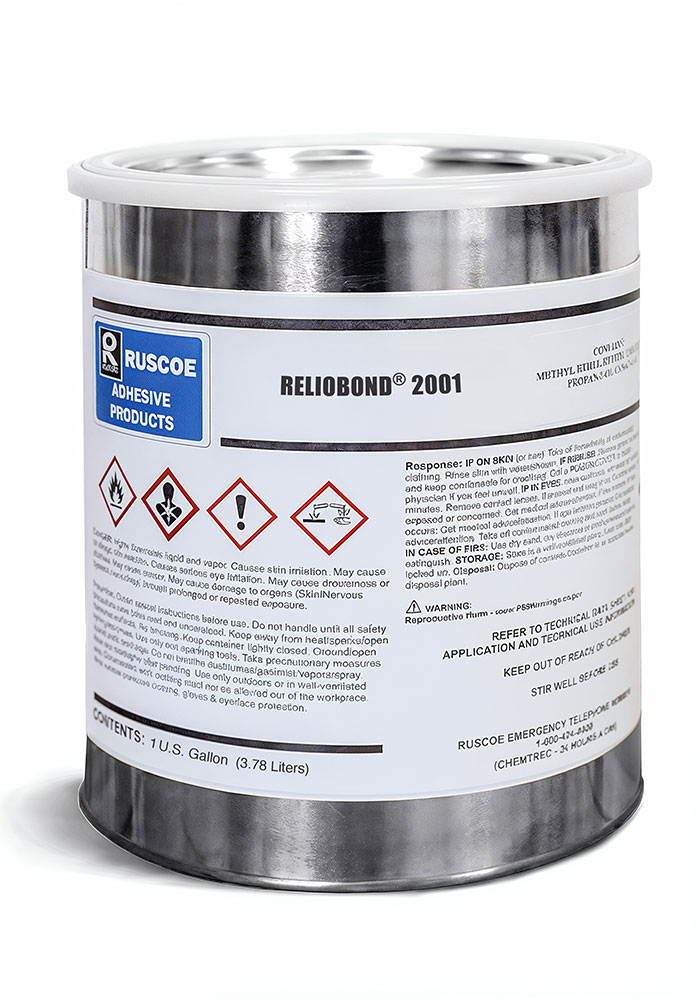Reliobond® 2001 Unmodified Phenolic Resin Adhesive
Reliobond® 2001 is an unmodified phenolic resin adhesive in solvent with a black dye.
SUGGESTED USES
Reliobond 2001 is recommended as an adhesive for disc brake backing plates or as a dip primer for drum brake cores or clutch rings.

Reliobond® 2001 adhesive, as supplied, is well suited for roller application and “dip and spin” applications. Manual or automated roller machines can be used depending on the number of parts that need to be coated per day. The resin can be diluted down in polar solvents such as ethanol, methanol, and acetone if desired. Over dilution below 20% solids is not recommended for roller application.
- Clean the steel backing plate with degreaser detergent of some kind.
- Grit blast to roughen the surface (optional).
- Coat the steel backing plates with resin. Reliobond 2001 has a black dye added so the coated backing plates are easily distinguished visibly from uncoated backing plates.
- Apply the resin with a roller or brush. Resin can be applied like a solvent based paint. Either manually or by automated process. It is critical to coat the surface evenly without void spaces.
- Alternatively, dip the entire steel plate (both sides in bath of liquid resin. Often this is done by placing several steel plates in a perforated cage. Coating both sides will provide corrosion protection to the back side (nonfriction side). Pull the steel plate out of the bath and let it drip excess resin back into the bath.
- Lay the plates down horizontally to dry before stacking them. The solvent evaporates quickly and usually 4-6 hours at room temperature is sufficient to evaporate the solvent leaving behind a thin film of resin adhesive.
- If necessary, faster drying can be done using low temperature ovens and/or forced air fans. Do not “over dry” since the resin is heat reactive. Low oven temperatures (40°C – 50°C) are better. Minimize the time in the oven. Do not dry the adhesive at elevated temperatures >80°C as this will B-stage (partially cure) the resin. The B staged adhesive coated steel plate will have less cohesive strength when the friction material is bonded to the steel plate. Shear strength of bonded friction material will be lower.
- Although 1 coat of adhesive is usually sufficient, in some cases it is necessary to repeat steps 3-5 to achieve the thickness needed for proper bond strength. Approximately 0.002 inches (2 mil) is a good starting target thickness. However, each customer must determine the exact value needed by trial and error using shear strength data as your quantitative measurement of adhesive effectiveness.
- Adhesive coated steel backing plates can then be used in any positive press of flash molding operation. The resin adhesive will melt and cure with heat and pressure forming a strong bond with the backing plate while bonding with the friction material. Normal molding operations are done between 145-175°C for 2 – 5 minutes, followed by a post bake in an oven at 175-200°C for 2-6 hours. The adhesive should cure and bond well under these conditions.
This product is a heat-reactive material and should be stored in closed containers at, or below 80ºF. Shelf life is 12 months from date of manufacture when stored appropriately. See Safety Data Sheet for more information on storage and disposal.
Health and safety data sheets available upon request at The Ruscoe Company.
Typical Properties:
| Color | Black | |
| Solids, by Weight % | 40% | |
| Solvent Formulation | Ethanol | |
| Density | 8.2 #/gal | |
| Viscosity, Ford Cup | 10 seconds | |
| Shelf Life | 12 Months |
